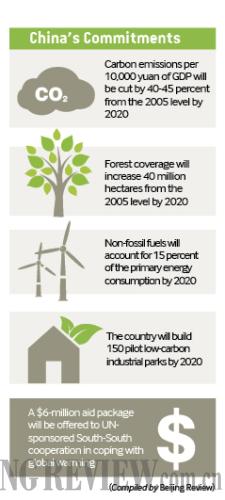|
Over the past several years, China has made remarkable strides in cutting emissions. For example, in 2013, the carbon intensity in China dropped by 28.5 percent from the 2005 level, which was equivalent to a reduction of 2.5 billion tons of CO2 emissions, Zhang said.
"This happened not because of others' requests but on our own initiative," Zhang stressed.
New growth path

China's efforts to cut emissions and increase energy efficiency are not only to cope with climate change, but also for the purpose of curbing environmental pollution and improving air quality, said Qin Dahe, an academician with the Chinese Academy of Sciences.
The Chinese Government has been taking serious measures to curb air pollution since many cities suffered heavy smog last winter. Clean air for the first time in years has become a top priority over GDP in the eyes of most Chinese people.
Unlike developed countries, China must undertake the tough task of helping a large population live better through economic growth while at the same time improving the environment.
Low-carbon growth is key for China to realize its development goals in the following decades. The resource-based growth model is unsustainable for a developing country like China with a population of 1.3 billion, said Zhou Dadi, an energy researcher at the National Development and Reform Commission, China's top economic planner.
According to Zhou, China must transform to a more suitable development path, change its energy mix and promote the use of clean and renewable energy.
The Medium-Term Renewable Energy Market Report 2014, issued by the International Energy Agency, said that China has become a major market of renewable energy. In 2013, newly installed renewable energy capacity in China accounted for 40 percent of global growth. This figure could be 60 percent for new capacity in non-member countries of the Organization for Economic Cooperation and Development. The report concluded that factors including huge power demand, pollution reduction targets and stimulus policies would continue to contribute to the growth of China's renewable energy sector.
China is experiencing unprecedented scale in its efforts to increase the use of renewable energy, according to Draugelis.
"Now we see China as a major leader in renewable energy in the world," Draugelis said. "We are pleased that we are continuing this partnership with China. Not only through investment, but also for major policy engagement with the Central Government on how we can continue to unlock greater use of renewable energy."
China as a developing country has rich experience in introducing and increasing a larger share of renewable energy, producing many key studies and lessons to learn policy application for technological innovation, Draugelis said. "Its experience is very valuable for other developing countries," he added.
In addition, China is speeding up the establishment of a carbon trading market.
China has already become the second largest market in the world, and has begun testing carbon pricing and trading regimes.
China is in talks with other countries and international organizations including the World Bank to establish a carbon pricing system around the globe.
Moreover, China attaches great importance to the development of energy-saving products and technology. It has become one of the largest exporters of solar panels as well as one of the largest exporters of LED products.
The industry of energy saving and environmental protection in China has seen rapid growth in recent years. By 2015, its annual output may reach 4.5 trillion yuan ($734 billion), creating over 30 million job opportunities, predicted Liu Yanhua, a counselor of the State Council.
Email us at: baishi@bjreview.com | 